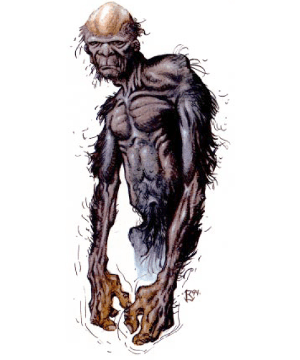

2433

| Climate/Terrain: | Mountains |
|---|---|
| Frequency: | Uncommon |
| Organization: | Clans |
| Activity Cycle: | Any |
| Diet: | Omnivore |
| Intelligence: | Low (5-7) |
| Treasure: | Q |
| Alignment: | Neutral |
| No. Appearing: | 1-20 |
| Armor Class: | 6 |
| Movement: | 12 |
| Hit Dice: | 5+1 |
| THAC0: | 15 |
| No. of Attacks: | 3 or 1 |
| Damage/Attack: | 2-9 (’┐Į2)/1-10 or by weapon |
| Special Attacks: | Headbutt, +1 attack |
| Special Defenses: | Nil |
| Magic Resistance: | Nil |
| Size: | H (13’┐Į tall) |
| Morale: | Steady (11-12) |
| XP Value: | 270 |
Psionics Summary
| Level | Dis/Sci/Dev | Attack/Defense | Score | PSPs |
|---|---|---|---|---|
| 4 | 1/1/3 | ’┐Į/IF | 7 | 20 |
Psychometabolism ’┐Į Science: shadow form; Devotions: adrenaline control, body weaponry, flesh armor.
The tul’┐Įk is a bony creature that predominantly inhabits the mountains of Athas, but it has been seen in other terrain.
It is a gaunt, primitive, humanoid that stands as tall as a half-giant. Its scalp lacks any skin or hair, leaving sun-bleached white bone to protrude through the top of its head. The tul’┐Įk’┐Įs low brow and large nose gives it an almost neanderthal visage. Its skin is an ashen gray. It has body hair similar to a human’┐Įs, that ranges from black to gray.
Combat: In melee combat tul’┐Įks are formidable foes and are unexpectedly cunning. A favored tactic of the tul’┐Įks is to set ambushes among the rocks of their mountain homes. If given the opportunity to prepare, tul’┐Įks use their shadow form ability in order to get close to their quarry.
When in melee, tul’┐Įks prefer to use their large, bony hands as clubs. Their arms are unusually long and give the tul’┐Įk a +1 THAC0 bonus in melee combat against creatures of the same size or smaller. These attacks can deliver 2-9 (1d8+1) points of damage. Alternately, they may use the psionic ability of body weaponry to turn their hands into weapons, if the combat seems to be going against them.
Once each round tul’┐Įks can use the exposed bone on their heads to butt their foes for 1-10 (1d10) points of damage. On a roll of 20, the victim must make a successful save vs. petrification or be knocked unconscious for 1d4 rounds.
The tough, leathery hide of these creatures affords them an AC 6. They also have the psionic devotion of flesh armor that is cumulative with innate AC.
Habitat/Society: Tul’┐Įks are the degenerated remnants of the Dune Stalker elven tribe. The mysterious Pristine Tower altered the elf tribe, turning them into tul’┐Įks.
Tul’┐Įks group into bands of as many as 20 members. They are nomadic within the territory they call their home. They have a primitive form of communication that consists of grunts, growls, and hand signs. The hand signs are generally used in combat.
The largest and strongest member of the clan is the leader, and as with many animals, the dominant male is the sire of most offspring. The young that are born of a male other than the dominant male are allowed to grow old enough to fend for themselves and are then exiled from the clan. If the child’┐Įs mother, or the child himself, can drive off the clan leader when he attempts to exile the child, the child is allowed to remain. Exiles that survive are rogue tul’┐Įk and are not accepted by any clan. New leaders ’┐Įpardon’┐Į all offspring conceived prior to their tenure and the young are allowed to stay with the clan.
Tul’┐Įks have a strong affinity for gems and jewelry. They hoard and protect their treasure to the best of their ability (though not usually to the death). They are never found with treasure of any other kind.
Ecology: While tul’┐Įks are primitive creatures, they are not malicous. In fact, they are outright timid with most intelligent races. They attack only to obtain food. Though attacks on humans and humanoids are not unheard of, they normally occur in times when other tul’┐Įk food sources have become scarce. Favored food sources of tul’┐Įks include Athasian rots, z’┐Įtal, and erdlu.
Last Modified: January 27, 2010, 07:25:10 GMT

◆ 1868 ◆